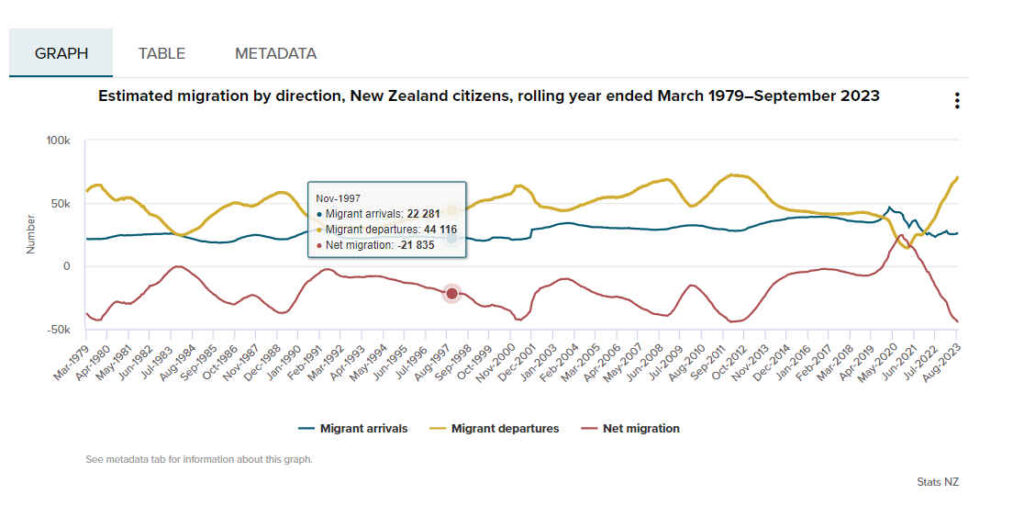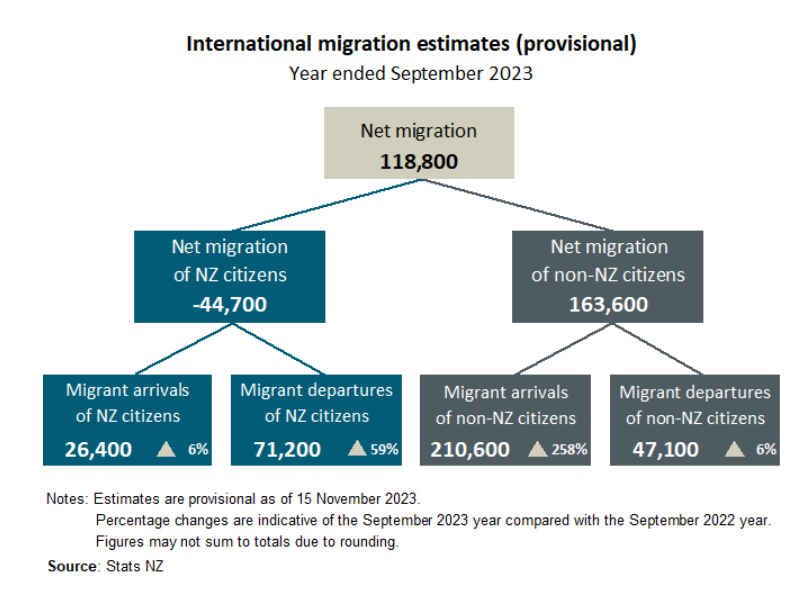There was a record net migration loss of 44,700 New Zealand citizens in the September 2023 year, according to provisional estimates released by Stats NZ.
This net migration loss was made up of 26,400 migrant arrivals and 71,200 migrant departures.
“Migrant departures of New Zealand citizens are just under record levels,” population indicators manager Tehseen Islam said. “Based on the latest estimates available, just over half of these departures went to Australia.”
The previous record net migration loss of New Zealand citizens was 44,400 in the February 2012 year.

Before the COVID-19 pandemic, New Zealand usually had an annual net migration loss of New Zealand citizens. See International migration: September 2023 for more information on trans-Tasman migration.
Non-New Zealand citizens drive overall net migration gain
There was a record overall net migration gain of 118,800 in the September 2023 year. This was driven by a record net migration gain of 163,600 non-New Zealand citizens, mainly of India, the Philippines, China, Fiji, and South Africa.
This follows a progressive relaxation of COVID-19-related border restrictions from early 2022, as well as changes to immigration settings.

Before the COVID-19 pandemic, non-New Zealand citizens were the main driver of New Zealand’s annual net migration gains, with recent September years (2015–2019) averaging net gains of 61,300 non-New Zealand citizens a year.
Migration driven by adults under 45
Migrants aged 18–44 years made up 67 percent (142,100) of the 210,600 migrant arrivals of non-New Zealand citizens in the September 2023 year.
Migrants aged 18–30 years accounted for 39 percent (27,800) of the 71,200 migrant departures of New Zealand citizens in the September 2023 year.

Migrants are people changing their country of residence, regardless of their country of citizenship or visa status. A 12-month threshold is used to classify migrants from non-migrants, aligned with international guidelines on measuring migration.
‘Country of citizenship’ is the nationality of passport used to arrive in or depart from New Zealand, and is not necessarily the country of previous or next residence.
Changes in migration are typically due to a combination of factors. This includes relative economic and labour market conditions between New Zealand and the rest of the world, and immigration policy in New Zealand and other countries.
Migration is a key contributor to population change in New Zealand – for provisional estimates see National population estimates: At 30 June 2023 (published 16 August 2023) and Subnational population estimates: At 30 June 2023 (published 25 October 2023). National population estimates: At 30 September 2023 will be published on 16 November 2023.

Just wait until we’re “culturally enriched” by Palestinians next year (because it’s the right thing to do™️).
No-go zones and trucks-of-peace coming to a city near you!!